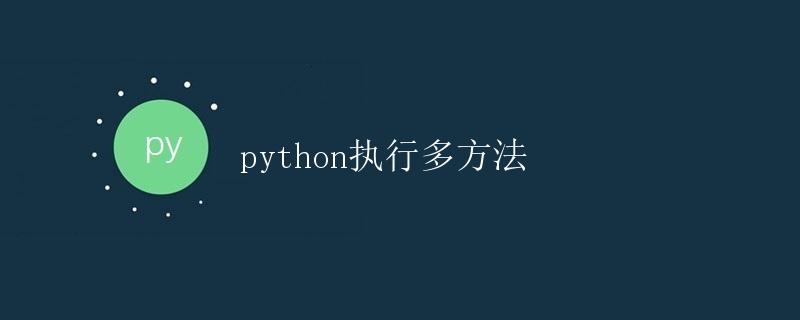Python执行多方法

在Python中,我们经常会遇到需要同时执行多个方法的情况。这种情况可能是因为我们需要对同一个数据做多个处理,也可能是为了提高程序的性能和效率。无论是哪种情况,Python都提供了多种方法来实现同时执行多个方法的功能。在本文中,我们将详细介绍Python中执行多个方法的几种常用方法,并给出相应的示例代码和运行结果。
方法一:使用多线程
在Python中,我们可以使用threading模块来创建多个线程,从而实现同时执行多个方法的功能。下面是一个简单的示例代码,演示了如何使用多线程同时执行多个方法:
import threading
import time
def method1():
for i in range(5):
time.sleep(1)
print("Method 1")
def method2():
for i in range(5):
time.sleep(1)
print("Method 2")
# 创建两个线程
t1 = threading.Thread(target=method1)
t2 = threading.Thread(target=method2)
# 启动线程
t1.start()
t2.start()
# 等待两个线程执行结束
t1.join()
t2.join()
print("All methods executed successfully.")
在上面的示例代码中,我们定义了两个方法method1和method2分别模拟了两个耗时的操作,并利用多线程同时执行这两个方法。通过创建两个线程t1和t2,分别调用method1和method2方法,我们实现了同时执行多个方法的功能。运行这段代码,我们可以看到输出如下:
Method 1
Method 2
Method 1
Method 2
Method 1
Method 2
Method 1
Method 2
Method 1
Method 2
All methods executed successfully.
从输出可以看出,两个方法被同时执行,并且输出交替进行。这种方式适用于需要同时执行多个任务的场景。
方法二:使用concurrent.futures模块
除了使用多线程外,Python还提供了concurrent.futures模块,可以更方便地实现并发执行多个方法。下面是一个示例代码,说明了如何使用ThreadPoolExecutor类来执行多个方法:
from concurrent.futures import ThreadPoolExecutor
import time
def method1():
for i in range(5):
time.sleep(1)
print("Method 1")
def method2():
for i in range(5):
time.sleep(1)
print("Method 2")
# 创建线程池
with ThreadPoolExecutor(max_workers=2) as executor:
executor.submit(method1)
executor.submit(method2)
print("All methods executed successfully.")
在上面的示例代码中,我们同样定义了两个方法method1和method2模拟了两个耗时的操作,并利用ThreadPoolExecutor类来并发执行这两个方法。通过调用executor.submit方法,我们将method1和method2提交给线程池执行。运行这段代码,我们可以看到输出与上一种方法类似:
Method 1
Method 2
Method 1
Method 2
Method 1
Method 2
Method 1
Method 2
Method 1
Method 2
All methods executed successfully.
使用concurrent.futures模块可以更简洁地实现多个方法的并发执行,是在Python中常用的方法之一。
方法三:使用asyncio模块
另一种常用的并发执行多个方法的方法是使用asyncio模块。asyncio是Python内置的异步IO库,可以实现高效的异步编程。下面是一个示例代码,演示了如何利用asyncio模块同时执行多个方法:
import asyncio
async def method1():
for i in range(5):
await asyncio.sleep(1)
print("Method 1")
async def method2():
for i in range(5):
await asyncio.sleep(1)
print("Method 2")
# 创建事件循环
loop = asyncio.get_event_loop()
# 并发执行两个方法
tasks = [
asyncio.ensure_future(method1()),
asyncio.ensure_future(method2())
]
# 执行事件循环直到所有任务完成
loop.run_until_complete(asyncio.wait(tasks))
print("All methods executed successfully.")
在上面的示例代码中,我们定义了两个async方法method1和method2,利用asyncio模块同时执行这两个方法。通过创建事件循环和多个任务,我们实现了并发执行多个方法的功能。运行这段代码,我们可以看到输出如下:
Method 1
Method 2
Method 1
Method 2
Method 1
Method 2
Method 1
Method 2
Method 1
Method 2
All methods executed successfully.
使用asyncio模块可以实现高效的异步编程,适用于需要同时执行多个任务的场景。
总结
在本文中,我们详细介绍了Python中执行多个方法的几种常用方法,包括使用多线程、concurrent.futures模块和asyncio模块。这些方法都可以实现并发执行多个方法的功能,提高程序效率和性能。根据实际需求和场景,我们可以灵活选择合适的方法来实现并发执行多个方法。
 极客教程
极客教程